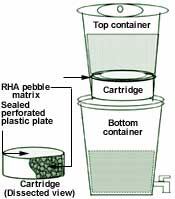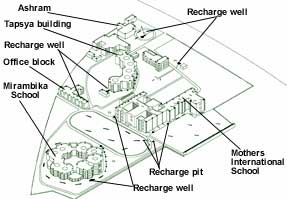| |
A NEW BEGINNING |
|
| Forging
ties
|
||
| WATER LITERACY | ||
| Informing
people Water play The facilitator Water Gala |
||
| IN FOCUS | ||
| Faulty
perceptions Thirst rises, patience evaporates |
||
| URBAN WETLANDS | ||
| Eviction
ordered Join the BIG fight Citizens pick up cudgels Solar lakes |
||
| WATER MANAGEMENT | ||
| South
India: Searching for an identity Thailand: Then came progress.... |
||
INITIATIVE |
||
| An eye
opener Naudihi’s revival Tankas of Badi Ghodan Dialogue |
||
CSE'S LATEST DESIGNS |
||
| Sri
Aurobindo Ashram’s system |
||
TECHNOLOGY |
||
| Rice
husk ash filter Clay pot irrigation |
||
| JAL YODHAS | ||
| Sachidanand
Bharti Madhu Bhatnagar |
||
TRADITION |
||
| Naullahs
of Kumaon |
||
WATER IN NEWS |
||
| Kerala,
building up its jalanidhi Schemes or scams? |
||
GREEN WATER HARVESTER'S NEWS |
||
| Saving
lives Rain associations Review |
||
CLASSROOM |
||
| Drop by
drop Water scramble |
||
FUNDING AGENCY |
||
| Oxfam
and water |
||
| 100
promises, deadline 2006 The landmarks Changing currents |
||

| Vol. 5 | No. 2 |
April-May 2003 |
|
| Find out the cost of implementing RWH
system from:R K Srinivasan / Saluddin Saiphy, Every Friday (2 -6 pm) at: India Habitat Centre, Core 6A, Fourth Floor, Lodhi Road, New Delhi 110003 Tel:011-26645334/5 E-mail: water@cseindia.org |
The designs ensure that the roofwater from all the four buildings within the campus - Mirambika School, Mother’s International School, Tapsasya and their office block gets collected for recharge in an integrated manner.
The runoff from Mirambika is diverted to a dry open well (about 18 meter (m) deep) through a network of pipes and collection chambers. The runoff from northern side of Mother’s International building gets accumulated in the three collection chambers. Then, after passing through a filtering media made of sand and pebbles, it is diverted to a recharge borewell (about 16 m deep). From the southern side, the water is diverted to a recharge well. Similarly, from the other two buildings, rainwater is channelised to an abandoned borewell.
The surface runoff from the unpaved (playground) and paved grounds (power station etc) is also collected and used for recharge. Sri Aurobindo Ashram is one of CSE’s upcoming model projects.
For details:PLBhola, Vice Principal
Mothers International School
Tel: 26524817, 26865400
Rice husk ash filter
 The incidence of water borne diseases has drastically reduced in the 180
households of Pusane village, Pune district. However, a few years back, the village was
plagued with such problems. All this changed, as they started using the rice husk
ash-based water filter designed by Tata Research Development and Design Centre (TRDDC), a
division of Tata Consultancy Services (TCS). It is a simple and low cost method to provide
safe drinking water.
The incidence of water borne diseases has drastically reduced in the 180
households of Pusane village, Pune district. However, a few years back, the village was
plagued with such problems. All this changed, as they started using the rice husk
ash-based water filter designed by Tata Research Development and Design Centre (TRDDC), a
division of Tata Consultancy Services (TCS). It is a simple and low cost method to provide
safe drinking water.
The filtering medium is made up of rice husk ash (RHA), which is abundantly available in rural India. RHA contains activated silica and carbon that helps in removing colour, odour, suspended particles and microorganisms. Cement is used as the binder while pebbles support the matrix. The filter has two parts. Its top portion is made of food grade plastic material (a form of plastic approved to keep food items) - costing Rs 150. It can be reused after the expiry of the filter element's life (6 to 8 months) by replacing the filter bed. The cost of such replacement is Rs 25. The lower part of the filter could be any container of the user's choice. TRDCC does not manufacture or sell the filters. Sevalaya in Chennai and Indian Institute of Youth Welfare in Nagpur are some of the organisations promoting it as well. Till date, more than 4,200 filters have been installed, with encouraging results.
For details:Dr Kalyan K Das,
TRCDDC, kkdas@pune.tcs.co.in
 To
stop even a drop of rain from flowing out of its campus,Mother’s International
School, New Delhi, approached CSE for technical guidance. "We went for one of
CSE’s miscellaneous services in 2002, and realised the need to extend the water works
done in 1995 to the entire campus, covering an area of over 95,870 square meters (sq
m)", informed PLBhola, vice principal of the Mother’s International School,
located within the Aurobindo campus. Expressing concern he said that, "The water
table is around 27.4 meters (m) below ground level, and we do not want situation to
deteriorate any further".
To
stop even a drop of rain from flowing out of its campus,Mother’s International
School, New Delhi, approached CSE for technical guidance. "We went for one of
CSE’s miscellaneous services in 2002, and realised the need to extend the water works
done in 1995 to the entire campus, covering an area of over 95,870 square meters (sq
m)", informed PLBhola, vice principal of the Mother’s International School,
located within the Aurobindo campus. Expressing concern he said that, "The water
table is around 27.4 meters (m) below ground level, and we do not want situation to
deteriorate any further".